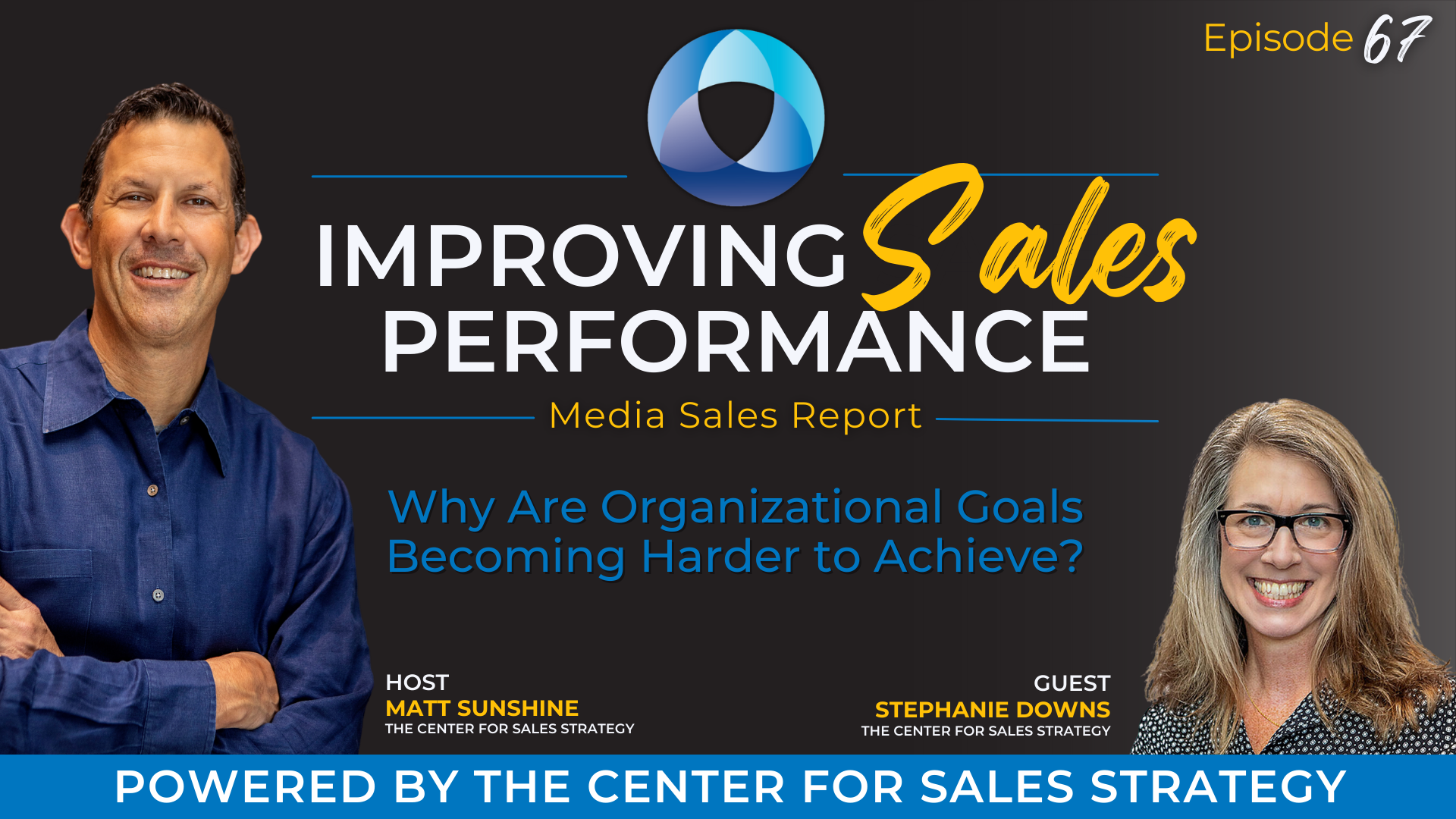
In this episode of Improving Sales Performance, we’re once again diving into The 5th Annual Media Sales Report by The Center for Sales Strategy.
Today, we’re exploring why sales managers are experiencing such increased difficulty in achieving organizational goals.
Joining Matt to discuss that and much more is Stephanie Downs, SVP/Senior Consultant here at CSS. Stephanie provides valuable insights, like:
- How a sales manager’s calendar should reflect a strategy of developing and coaching their people
- Why we often make recruitment harder on ourselves by not having a firm plan in place
- And, finally, why adding more people to your sales team is not always the solution
A Sales Manager’s Calendar Should Reflect a Coaching and Development Strategy
The conversation kicks off with a key finding from the report: 81% of sales managers are finding it increasingly difficult to achieve their company's goals.
Stephanie emphasizes the importance of aligning a sales manager's calendar with strategies for developing and coaching team members.
She says, “If I were a sales leader, I would pay attention to my calendar. Here's what I mean by that. I would look at my calendar and ask, ‘Does my calendar reflect the strategy of developing and coaching people, or does my calendar reflect something very different from that?’
“My guess is that it may not reflect the strategy of coaching and developing people, and our people are our biggest asset. They should be where we're investing the majority of our time.”
She goes on to suggest reassessing your current structure if goals aren’t being met.
“Something else that I would recommend,” she says. “...ask yourself a few simple questions about your current structure, like: is your current structure doing what it was designed to do?
“And, if not, think about the KPIs that you’re paying attention to, your performance metrics, whatever those are. What of those are not being achieved, and what in the structure is not supporting that?”
Build Talent Banks Year-Round
The discussion then shifts to recruitment challenges, with 43% of sales managers identifying it as the hardest part of their job.
Stephanie offers practical advice for making recruitment more effective, advocating for a proactive approach that involves building a talent bank year-round and leveraging employee and client referrals.
She says, “I don't want to minimize the fact that it's hard out there, but I think we also make that harder on ourselves too because we often don't have a plan in place, right? Or we do it only when we have open positions and not year-round.
“We should be building our talent bank all the time.
“And I think that sales leaders also feel the pressure that they have to do it all themselves. Don't do it in a vacuum. Get people to help you. Have a team:
- Ask your employees: Create employee incentive plans to get referrals from them.
- Ask clients for referrals: Use nominator questions to make an effort when you are recruiting better. Don't just say who are the best sales people.
- Call on those who problem-solve on a regular basis: Who has the best ideas? Who are naturally inquisitive?
“Think about what that outbound effort looks and sounds like.
“But, you know, it goes back to what we were saying earlier about your strategy on the calendar. You have to put 60 minutes on the calendar every week when you are actively having candidate conversations, searching on social media, or reaching out to clients. You have to have a strategy to support it.”
Adding More Salespeople to Your Team is Not Always the Solution
Another key finding from the report is that 53% of sales managers express dissatisfaction with the size of their sales teams.
Stephanie addresses this issue by highlighting the importance of performance analysis and talent optimization. She advocates for a focus on cultivating a team of high-performing individuals rather than simply increasing headcount.
“Let's be honest,” she says. “It's a hard place to find the exact right number of people. But adding people to the team is not always the solution.
“And I think a lot of sales leaders default to that mindset of, ‘I need more people. I need more people in the street. I need more people calling on people.’ It's not always the solution.
“Here are a couple of thoughts on that from a talent standpoint; I would ask: Do you have non-performers on the team? Are there people that are not consistently performing?
“And I know, Matt, you and I've had this conversation a number of times, but think how often we've heard, ‘not everybody on the team can be an A player.’ That drives me crazy! Hearing that is like nails on a chalkboard, right?
“My immediate response is, ‘why not?’ It doesn't mean that it's easy to have all ‘A players’ on the team, but we should have the mindset that we should have all ‘A players’ on the team. We should strive to get there.
“So, when thinking about the size of your sales team, I would start by doing some sort of performance analysis over a period of time. Look at everybody and how they're contributing to the overall organization.
“If you have C players, get them to be B or an A player, or consider moving them out of the organization, etc.
“Have the mindset of all striving for a team of A players.”





